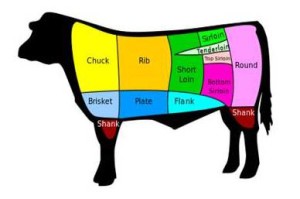Cuts of Beef Explained
April 5th, 2016
How is your knowledge on cuts of beef? Most of us have been eating and buying meat, whether from a butcher or a fine restaurant, for most of our lives. We have a general idea of what is a better cut than another but other than a basic understanding are lost. By not really knowing the different cuts of beef we tend to stay within our comfort zone when buying or ordering beef. Our aim is to open up your taste buds and expand your options the next time you order beef.
As you can see from the image there are quite a few cuts of beef. We all have heard of sirloin or tenderloin, rib eye or flank. But what is the difference? Which is better grilled or for a stew? That is important knowledge when buying for personal consumption or ordering from a white linen restaurant that offers South Shore Meats selection.
There are too many for one blog post so you will see us discuss this in different posts, we will also clue you in on Veal, Lamb and Pork. Your palate will appreciate it and so will your wallet. Welcome to the world of BEEF!
Today is an introduction – in other blogs we will get to specifics.
Lets start with the reason one cut is more tender than another. It is directly related to how much the muscle is used during the steers’ life. Without getting very technical, (do you really need to know what a Longissimus dorsi is?), I will try to use very basic terms wherever possible. You don’t need to be an expert in the language of beef to know the difference in the cuts. As you can see the steer is divided into several areas. Some are where the most tender cuts of beef are found and others where ground or stew beef is located.
At South Shore Meats we believe an educated consumer is the best consumer. Your clientele will appreciate your menu even more now that they can be a bit more adventurous in ordering.

Image courtesy of http://visual.ly/cuts-beef
http://www.beefretail.org/beefcutcharts.aspx
